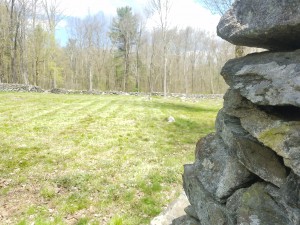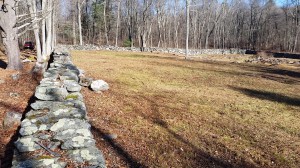
Download Map
Deer Park and Coxhall Kitchen Garden

 The East Quabbin Land Trust encourages visitors to all of its preserves. Please be respectful of the land and other visitors. EQLT has several policies that guide use of the land, including a Dog Walking Policy, Hunting and Fishing Policy and Recreational Trail Use Policy. We encourage you to go explore the Coxhall Kitchen Garden.
The East Quabbin Land Trust encourages visitors to all of its preserves. Please be respectful of the land and other visitors. EQLT has several policies that guide use of the land, including a Dog Walking Policy, Hunting and Fishing Policy and Recreational Trail Use Policy. We encourage you to go explore the Coxhall Kitchen Garden.
The Coxhall Kitchen Garden is a stone wall enclosure about 200 feet square, or nearly one acre in area. Access is on Simpson Road about 1000 feet south from Ruggles Hill Road in Hardwick. There is no street sign at this intersection, so look for two large oak trees that mark the road intersection.
The Coxhall Kitchen Garden borders the easterly side of Simpson Road. The property was donated in 2007 along with much of the Deer Park Preserve. Click here for the interpretive trail map for Coxhall Kitchen Garden and Deer Park Preserve.
 The walled enclosure sits on a tract of land once owned by Brigadier General Timothy Ruggles, who bought the land from Elizabeth Cox in 1771. Known now as the Coxhall Kitchen Garden, this roughly one-acre walled area was built by Ruggles a few years after he purchased the land. Traditional English walled gardens were intended to keep wandering animals out and to create microclimates for fruits and vegetables. The warm side of the walled garden was used for sowing in early spring, while the cool side was planted later to extend cool season crops into the hotter summer months.
The walled enclosure sits on a tract of land once owned by Brigadier General Timothy Ruggles, who bought the land from Elizabeth Cox in 1771. Known now as the Coxhall Kitchen Garden, this roughly one-acre walled area was built by Ruggles a few years after he purchased the land. Traditional English walled gardens were intended to keep wandering animals out and to create microclimates for fruits and vegetables. The warm side of the walled garden was used for sowing in early spring, while the cool side was planted later to extend cool season crops into the hotter summer months.
Timothy Ruggles was a prominent figure in the French and Indian Wars, and a controversial Loyalist in the Revolutionary War. Only three years after purchasing the property, Ruggles left Hardwick for Boston to accept the oath of the Mandamus Council. At the onset of the Revolution in April 1775, all of the Ruggles’ Hardwick property, including his “Cox Farm,” was confiscated because he was considered an absentee landowner and an enemy of freedom. Much of the land was sold at public auction, but the “Cox Farm” eventually reverted back to Elizabeth Cox in 1783.
This stone wall has withstood the test of time and the hazards of New England winters. Local stones of all sizes and shapes were carefully placed to form a fabric that shifts and moves to accommodate frost and provide drainage. The large stones were likely hoisted in place with tripod, block and tackle, planks, fulcrums, and levers.

